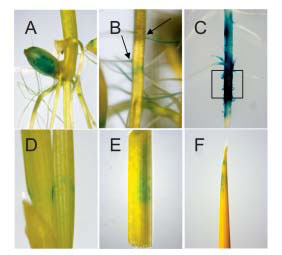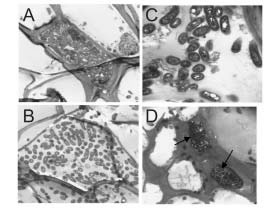Development of an experimental model for the evaluation of in planta colonization of nitrogen-fixing endophytes in rice plants
Description
[Objectives]
We have previously reported that large quantities of nitrogen-fixing endophytic bacteria symbiotically inhabit the tissue of gramineous plants. Currently, we have isolated a number of bacteria having nitrogen-fixing abilities, such as Azospirillum sp., Klebsiella sp., and Herbaspirillum sp. from various grasses. However, it remains necessary to establish a means of inoculation testing in order to investigate the colonization dynamics of these bacteria and elucidate how they contribute to the growth of important plant species. Hence, as an experimental model with which to verify the effectiveness of a new inoculation test method, we chose the bacteria Herbaspirillum sp. A46, originally isolated from Panicum maximum and rice plants. If successful, this method will serve as a foundation for analyzing the behavior of nitrogen-fixing bacteria within plants.
[Results]
Herbaspirillum sp. A46, marked with transposon-based gusA gene, was evaluated for its ability to colonize fodder rice. A total of three rice varieties were used as hosts: Sprice, which is a rice cultivar now used as silage, and two other traditional varieties, Tetep and Koshihikari. The bacteria, which possibly enter through cracks in the emerging lateral root of cv. Sprice, were localized in the inter- and intra-cellular areas of the cortical cells and the xylem vessels of the root; bacteria then systemically spread into the shoot portions, where they were found in the intercellular spaces of adjacent cells in the leaf vascular bundle (Figs. 1 and 2). Colonization began as early as two days after inoculation with numbers ranging from 105-107 per gram fresh weight. The population of isolated herbaspirilla remained constantly larger than of the bacteria isolated from the shoot 2 to 21 days after inoculation. In the case of bacteria isolated from shoots within the same sampling period, the population tapered only at 30 days after inoculation in all three varieties accompanied by a consequent increase in numbers of bacteria. Among the three cultivars, no significant differences were observed in the number of herbaspirilla isolated from the inner tissues except at seven days after inoculation, when the fodder rice, cv. Sprice, harbored the highest numbers of bacteria. The addition of 10μM NH4Cl inhibited the colonization of all three rice cultivars, of which cv. Koshihikari showed the highest sensitivity. Nitrogenous activity was detected in all three varieties in the absence of carbon sources until seven days after inoculation.
Figure, table
-
Fig. 1. Light micrographs of cv.
Sprice 7 days after inoculation. Roots were inoculated with Herbaspirillum sp. A46 marked with transposonbased gusA, showing the gus staining in the seeds (A), lateral root and root junctions (B), root tip region (C), stem (D), leaf sheath (E) and tip of leaf blade (F). -
Fig. 2. Transmission electron micrographs (70 nm sections) of cv.
Sprice roots 7 days after inoculation. Roots were inoculated withi Herbaspirillum sp. A46, showing the bacteria colonizing the intracellular portion (A, B) and intercellular space (C) of cortical cells, and protoxylem vessels of the vascular bundle (D).
- Affiliation
-
Japan International Research Center for Agricultural Sciences Animal Production and Grassland Division
- Classification
-
Technical A
- Term of research
-
FY2003 (FY2003-2005)
- Responsible researcher
-
ANDO Yasuo ( Animal Production and Grassland Division )
HERNANDEZ-OANE R. H. ( JIRCAS Visiting Research Fellowship Program )
SATO Kenzi ( Kyushu Okinawa Agricultural Research Center, NARO )
KOBAYASHI Ryoji ( Kyushu Okinawa Agricultural Research Center, NARO )
HATTORI Ikuo ( Kyushu Okinawa Agricultural Research Center, NARO )
ELBELTAGY Adel ( JIRCAS Visiting Research Fellowship Program )
- ほか
- Japanese PDF
-
2003_17_A3_ja.pdf2.71 MB
- English PDF
-
2003_17_A4_en.pdf66.45 KB


